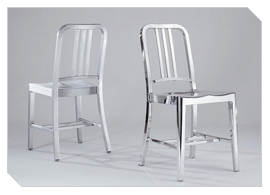

The Emeco Navy Chair is iconic in American design. Originally designed in 1944 for the U.S. Navy for use on submarines and destroyers, its popularity has endured because of the quality of construction and timeless good looks. Considered a classic and experiencing a new popularity, the Navy Chair can often be spotted everywhere from upscale interiors to television and movie sets.
Another American classic, The Coca Cola Corporation, has spent recent years promoting innovative ways to use material created from recycled plastic Coke bottles. They teamed with Emeco to create a new version of the classic Navy chair using recycled bottles, instead of the traditional hand-brushed aluminum. The chair would be called the “111 Navy Chair”, derived from the approximate number of recycled bottles it would take to create the chair.
Recreating the Navy Chair in a new medium presented an engineering puzzle that was best solved using 3D technology. The original version of the chair is carefully handmade in a complicated 77 step process. Each chair, while essentially alike, is handcrafted by artisans with years of experience welding and surface finishing the aluminum. The new 111 Chair would need to retain the exact, iconic look of the original but would have to use a standard injection molding process to work with the recycled Coca Cola material.
To create a mold, they would need a CAD file of the chair. The file would need to be an exact replica of the original chair but would also need to be scalable to account for shrinkage typical of the molding process. Due to the handcrafted nature and organic elements of the chair, such as the seat, it would also be nearly impossible and very time consuming to draw in a typical CAD program.
It was actually a bit of luck that led to a solution. Magnus Breitling, Emeco’s Director of Product Development had been told to contact Direct Dimensions in regards to another enquiry. He stopped in at the Owings Mills office one day to meet with Charlie Matlin, Direct Dimension’s Sales Manager. While discussing potential work, they came up with the solution to the 111 Chair, which was to rapidly laser scan and digitally reverse engineer the Navy Chair and deliver a CAD file. With the file provided by DDI, the engineers at Emeco could have a mold made for the new Navy 111 Chair.
Direct Dimensions technicians digitized and laser scanned a Navy chair using a portable FARO Scan Arm system. The FARO system provides users both a contact probe for high accuracy geometric features and a non-contact laser scanner for complicated contoured surfaces.
With the complex contours of the chair accurately captured as a set of raw 3D points, the Direct Dimensions team reverse engineered the chair using Rapidform’s XOR reverse engineering software. The model was also scalable if needed to account for plastic shrinkage that is common in the injection molding process. This reverse engineering process gave the team at Emeco true CAD models of their original chair in a format suitable for the creation of a mold.
The 111 Navy Chair debuted at the 2010 Salone Internazionale del Mobile, one of the top furniture trade shows in the world, to great acclaim and can be purchased through on-line retailers.